It’s taken awhile for Oklahoma to warm up this year. Temperatures in the low 30s lingered into April.
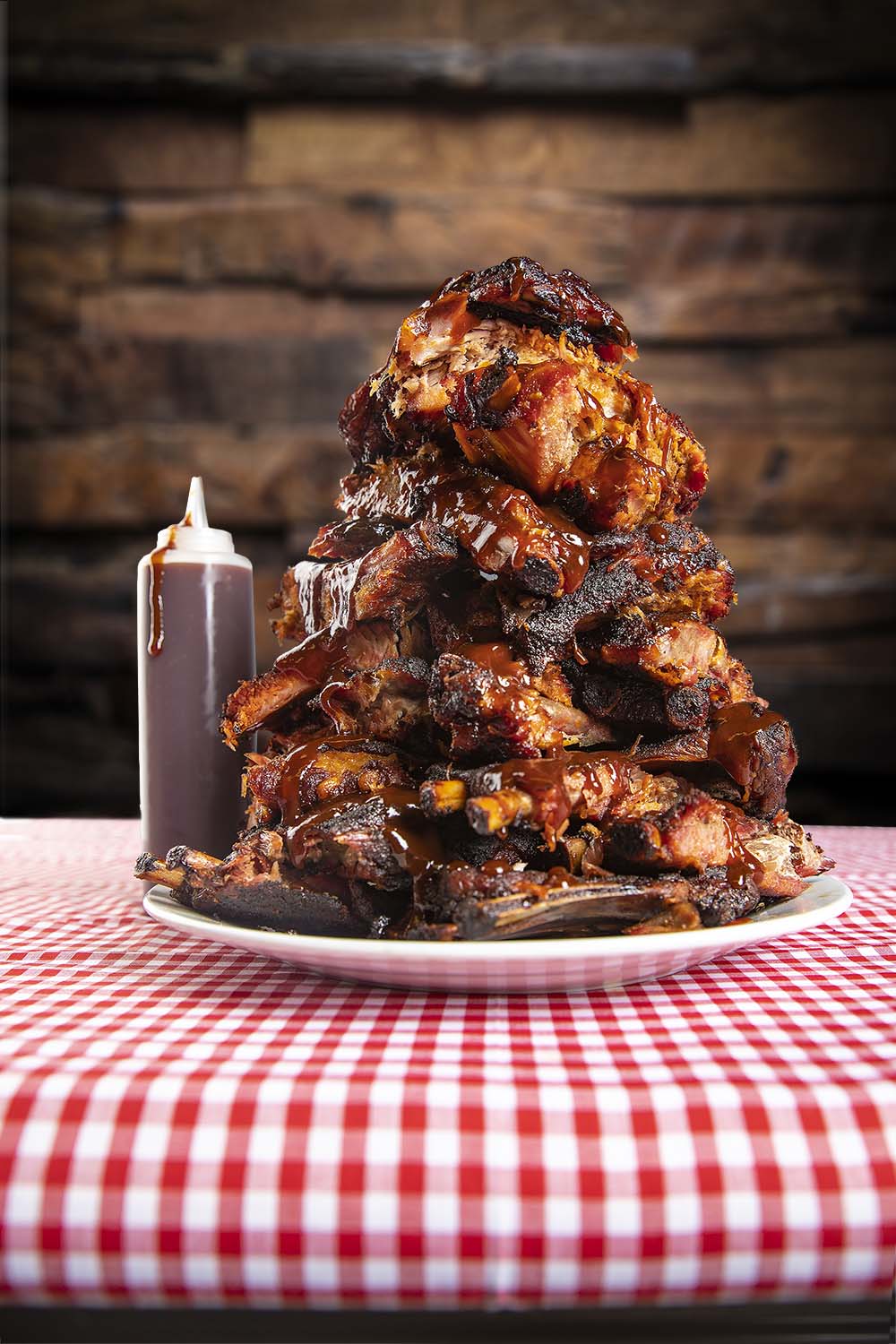
Despite the late spring, we’re back on target this month and the high heat is coming as summer awaits and people uncover and dust off their grills and smokers.
In our annual section on outdoor cooking, we get away from the norm of hamburgers and hot dogs and explore weird foods, like fudge, that you can grill over the coals.
Tasty sausages, in their raw state, can pose challenges on the grill. We show you how to be the best with brats. We also examine the advantages of the main types of charcoal grills.
Also included are short takes on grilling with skewers and a debate over hickory and mesquite as woods that add flavor to your food as you cook it.
We have a quick rundown of some new barbecue equipment on the market.
Experts weigh in on what makes a good homemade barbecue sauce. There’s even a glossary of sauces by region of the country and the world.
Opinions vary, but those differences make for robust discussion about a favorite Oklahoma pastime – outdoor cooking.
9. What Wood You Prefer?
It’s a non-debate debate – or a debate non-debate: distinct and resonate vs. sweet and subtle … mesquite vs. hickory. Regardless of an outright victor, those who grill and smoke love to flavor meat by burning wood.
The battle between hickory and mesquite, like most disputes in the outdoor cooking world, is good-natured. The rarest of species is someone who likes barbecue but refuses to eat because food has been grilled or smoked with chunks from a certain tree.
Jose Todd, assistant manager at Howler’s Famous Barbecue in Pawnee, favors mesquite because “it is a stronger, bolder taste than hickory. Wood-wise, it burns slower. You get a smokier taste.”
He adds – while chewing on a piece of brisket to examine the flavors – mesquite “is not sweet, so you can actually taste the meat; it doesn’t overwhelm the meat.”
In another corner is Andrew Timmons, executive chef in charge of research and development at Tulsa-based Rib Crib.
“I always use green hickory,” he says. “It’s not harsh or bitter and it’s readily available. It provides a good color and smoke ring.
“It provides better heat, too; it will burn the longest because it’s the hardest of the hard woods.”
The great news is that the home grill master doesn’t have to pledge allegiance to the tree. It’s OK to switch back and forth. The Barbecue Po-Po won’t come after you.
8. GO FOR THE WEIRD

Hamburgers, hot dogs and some vegetables comprise a typical backyard barbecue. However, if you see your grill as just a cooking surface with wood and charcoal as the heat source, your options become limitless.
Bananas, lettuce, eggplant, tofu, watermelon, pineapple, peaches, tomatoes, pizza, quesadillas, edamame, nuts, asparagus, Brussels sprouts, artichokes, bacon, polenta, lobster, avocados and chard are among scores of items you can plop on the grates.
Nick Corcoran, pit master at Tulsa-based Burn Co. Barbeque for seven years, could perform standup comedy with the shenanigans in his lair and some of the foods he’s grilled.
“What we do for a living is absolutely ridiculous because I have access to the best meats and food that you can get,” he says. “We have fun and play around with anything.”
Corcoran has grilled schnitzel, elk sausage, squirrel, lamb and alligator.
“Probably the most unusual thing I’ve done on the grill is fudge – salt-candy-bacon fudge,” he says. “It didn’t go over too well, but I liked it and ate most of it myself.”
OKC’s Scotty Irani, of the In the Kitchen With Scotty, recalls foods at beach parties while he was in culinary school in Rhode Island.
“Grilled oysters and clams are phenomenal,” he says. “The trick is to find those big, gnarly, thick mollusks, then toss them on the grill until they open. Knock out some garlic-herb butter, shuck the clams and oysters, spoon in the butter and place them back in the shells on the grill to cook.
“Can you taste it? I know you can.”
7. CHARCOAL GRILL TYPES

Traditionalists in the outdoor cooking world eschew electricity (pellet cookers) and propane (gas grills). They go for charcoal and wood and fire.
The equipment they use, however, may vary. Dillon Stockard at Everything Barbecue in Oklahoma City runs down the advantages of various types of charcoal grills.
• Barrel – “The cooking surface is large. It’s a vertical style and you have several tiers, so you can get a lot of food on there,” Stockard says.
• Brazier and kettle – Each of these basic grills is essentially the same (charcoal pan, grill and lid). The former is rectangular; the latter is (surprise) shaped like a kettle. “People love the nostalgia of either. It’s the grill that people saw their grandpa or father using.”
• Crank-style – Hasty-Bake of Tulsa patented this type. “You have the versatility to easily move the charcoal around,” Stockard says.
• Kamado or egg – The names are interchangeable, with Big Green Egg and Kamado Joe well-known for this style. “It’s a complete, three-in-one cooker – grill, bake and smoke. Most also have a lifetime warranty.”
In addition, Stockard says the materials of the cookers make a difference.
“The advantage of metal comes in smoking meat,” he says. “Metal provides a drier cooking environment, so you get a more pronounced smoke ring and bark.”
Ceramic cookers “are fantastic if you want to grill basic burgers, steaks, chicken or sausages because of the moisture, flavor and heat retention,” he says.
6. Fowl Weather Ahead

What makes chicken and other winged meats popular today – the relatively low fat content – is also what makes grilling them a fair or fowl proposition.
Beef and pork have enough fat to make hamburgers and bratwurst juicy. However, poultry and flying game can dry out quickly on the grill because there’s nothing in them to keep the meat moist.
The key is getting the moisture in ahead of time with brines and marinades. For instance, brining chicken or turkey breasts for 1½-2 hours renders plump, tender, juicy meat hot off the grill.
Chef Scotty Irani, who runs his In The Kitchen With Scotty line of products out of Oklahoma City, says prepping fowl for the charcoaler is vital.
“When grilling game fowl, keep in mind that these birds – duck, pheasant, quail, dove, grouse – are going to be ‘dry,’ plus you’re using a ‘dry’ way of cooking them,” he says. “To counter-balance that, marinating or brining is always a good idea. Wrapping in bacon or classic ‘larding’ makes a tasty bird bite, too.
“Always make sure you’re grilling these guys to proper internal temperature – 165-170 degrees – especially if they truly are wild game fowl.”
5. sausage success
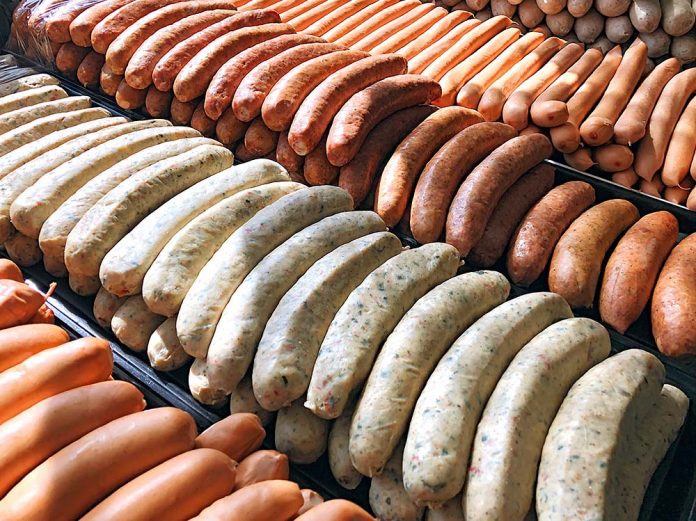
Charred on the outside. Uncooked meat on the inside. This dreadful state of affairs is why many people shun grilling raw bratwurst and sausages.
However, a little patience, a lot of experience and strategic charcoal placement produce casing after casing of ground, flavorful goodness.
“The key is heat control,” says Jeffrey Yates, deli manager for 10 years at Siegi’s Sausage Factory in south Tulsa. “Let them slowly warm up for even browning.”
Nick Corcoran, pit master at Tulsa-based Burn Co. Barbeque, makes sure he has direct and indirect sources of heat. He warms up and browns the brats away from the coals before finishing them over the fire.
“The casing will firm up and the sausage will firm up,” he says. “I know this sounds kind of funny, but as they become plump, they become bouncy as well. I’ve dropped one of the ground and it bounced up.”
Yates uses a feel test before pulling the sausages off the grill.
“When they’re nice and firm and tight, you know it’s done,” he says. “If tiny holes in the casing split open and clear juices come out, then they’re done.”
Puncturing the casing is a no-no because it keeps the meat moist and zesty, so a thermometer is out of the question. However, Corcoran suggests making one of the brats “a sacrificial lamb and cut into it. The others are going to be like it, so you’ll know if they are ready or need more time.”
Yates, whose favorites are ones with any type of cheese in them, says “sausages sometimes get a negative connotation because people think they’re just fancy hot dogs. They’re not. There are a lot of excellent, gourmet sausages out there.”
4. The Art of the Sauce
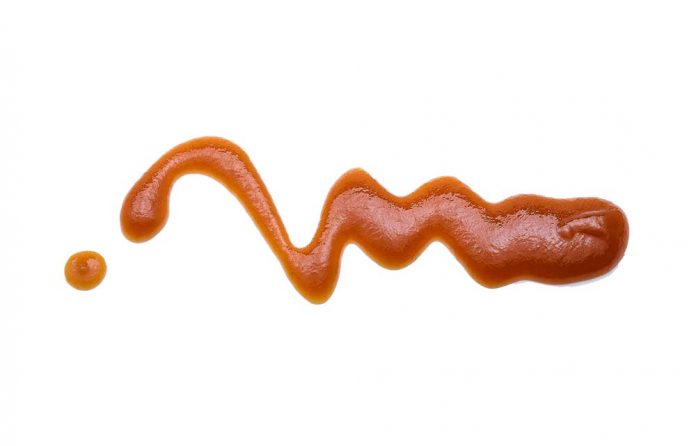
Just like foodie disputes over the best way to prepare fried chicken or which type of gravy is best, the art of making barbecue sauce is highly subjective.
With every grilling or smoking expert comes a different opinion on what is needed in a good sauce. Oklahoma Magazine talked with barbecue masters in Tulsa and Oklahoma City and got their preferences.
Nick Corcoran,
pit master, Burn Co. Barbeque,
metropolitan Tulsa
“Around here, we like sauce that’s thick, ketchup-based and sticky – something that you can put on a bun and not have it run off. I always use high-quality ingredients, like blackstrap molasses as a great addition to the ketchup base. Technically speaking, good barbecue shouldn’t need sauce, but, if you do use it, it should be used during the cooking process.”
Chuck Gawey,
owner, Albert G’s Bar-B-Q, Tulsa
“We put a lot of TLC in our sauce. You don’t want anything too, too sweet or too, too tangy or too, too hot. You want something versatile. I had a guy tell me that he puts our sauce on everything, including eggs. That’s what we want.”
Tomas Lopez, chef,
Iron Star Urban Barbecue, OKC
“It’s the sweetness, tanginess and spices altogether. It’s also important to have smokiness and something sweet, like molasses or brown sugar. Onion powder is a good addition, and I like some hot spice for a little kick.”
Brent Swadley,
third-generation owner,
Swadley’s Bar-B-Q, metropolitan OKC
“No. 1 is starting with the best ingredients. We only use Heinz ketchup as the base. We make our sauce fresh. Oklahomans generally like a sweet sauce, but some like it tangy, too, so that’s why we have four sauces. You want the sauce to complete your barbecue. It shouldn’t overwhelm the food. It should cling to the meat, not thickly cover it. It should drape the meat like being on the back of a spoon.”
3. A sauce gloss
Some states and regions in America, along with other countries, claim to produce the best barbecue sauces, which have tomatoes, vinegar or mustard as their bases. Here’s a look at various types.
Alabama White – As the exception to the rule, this state’s white barbecue sauce has mayonnaise as its base, mixed with lemon juice, salt, black pepper, white vinegar and sugar.
Australian – Down Under, the sauce is served as a condiment, not as something swabbed on meat during cooking. Generally, it’s ketchup or tomato paste diluted with Worcestershire sauce and mixed with paprika and that most Aussie of all staples, Vegemite.
Chimichurri – Common to Argentina and Uruguay (and in some parts of Brazil), this uncooked sauce is red or green, depending upon the use of tomatoes. It blends parsley, garlic, olive oil, oregano, vinegar and red pepper.
Chinese – Tomato puree is mixed with ginger powder, sherry, soy and hoisin sauces, five-spice powder (cinnamon, cloves, fennel, star anise and peppercorns), pineapple juice and garlic for a distinct taste.
East Carolina – Thicker than its West Carolina sibling (see below), this sauce still relies on vinegar and is mixed with crushed red pepper flakes and cayenne pepper (among other spices).
Florida – Since this state is home to many citrus fruits, it’s no surprise that grapefruit juice is a primary ingredient – mixed with brown sugar, red onion, garlic, tomato paste, dry mustard and Worcestershire sauce.
Kansas City – Makers of this sauce like to double down on its key ingredients: tomato sauce and ketchup, blended with brown sugar and molasses.
Korean – Onion, Asian pear and kiwi fruit provide the sweet and loads of garlic provide the sour. Soy sauce, ginger and sesame oil are other key elements.
Lexington/Piedmont/West Carolina – Known by all three names, this sauce uses ketchup, is thin and has lots of vinegar.
Memphis – This sauce is heavy on the tomato base and zesty spices, which makes it thick, sticky and tangy.
Oklahoma – Minced onion and garlic, crushed celery seed, ground cinnamon, nutmeg, ginger and cloves, paprika and either melted butter or olive oil give the Sooner State’s sauce a unique flavor.
Pacific Northwest – Pick your favorite fruit jam, jelly or marmalade from Oregon or Washington, then mix it with your favorite style of barbecue sauce.
South Carolina – The classic mustard-based sauce has lots of the prepared yellow condiment for even the smallest of batches. Honey and brown sugar provide some balance, but the tang goes up again with apple cider vinegar, chipotle pepper and Worcestershire sauce.
St. Louis – This blend of styles (tomato, mustard and vinegar) has some sweet (brown sugar) and heat (cayenne pepper).
Texas Mop – Ketchup or tomato sauce, vinegar, Worcestershire sauce, dry mustard and chili powder are among the flavors in the Lone Star State type.
2. SKEWERING A
COMPLETE MEAL
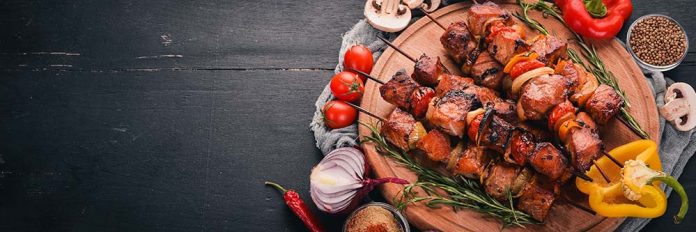
Often overlooked by backyard chefs is the humble skewer, which can bring a complete meal – meat, vegetable, fungi, starch and fruit – straight from the grill to each person.
The prep time is about the same. If they arrive early enough, you can let guests choose what they want on each skewer – such as two cubes of chicken, two potato wedges, three chunks of bell pepper, two mushrooms and a slice of pineapple.
“It’s a different way to eat than what people are used to doing with the grill,” says Dillon Stockard of Everything Barbecue in Oklahoma City. “It’s something nice to try. It’s easy, too – bite-sized food and you don’t have as much cleanup.”
Bamboo skewers are good because of their biodegradability and quickness to cool, so you can remove the hot food without burning your fingers. However, they don’t do well with high heat and can easily break or splinter.
Metal skewers stay hot and you can’t hold them with your bare fingers, but they last a long time, provide superior heat in the middle of a chunk of meat and should be washed after each use.
1. RECENT TECHNOLOGY
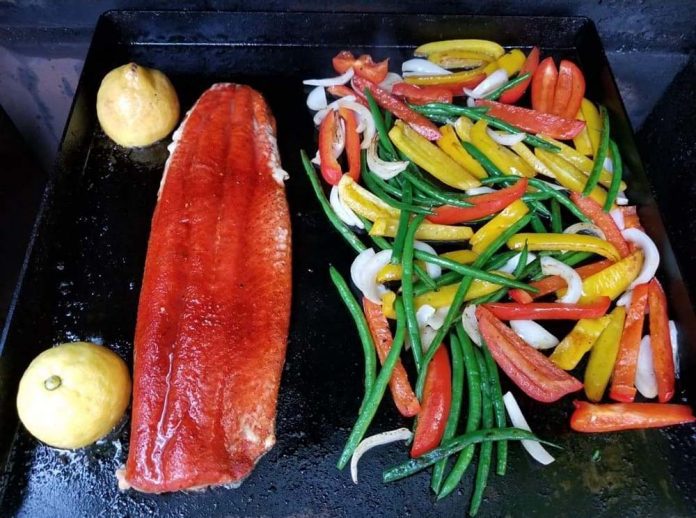
Grilling food over coals is as old as Homo erectus, so just about everything needed for barbecuing has been invented in the past 1.8 million years. However, some recently released products might grab people’s attention.
Dillon Stockard with Everything Barbecue in Oklahoma City touts some items that have made their way to the back porch.
- Kamado Joe has added features to its ceramic cookers, namely an air hinge, which uses a compressed spring to make easy lifting of the 125-pound lid, and a long-lasting gasket (seal) made out of ceramic and woven mesh with a life span of 10-plus years. Conventional felt, nomex gaskets last about five years.
- Several companies, responding to publicized instances of wires breaking off grill brushes and getting into food, have produced scrapers made out of bamboo or another hardwood. “You use it when the grill is hot; the tapered front conforms to the grates,” Stockard says.

- Smokin’ Brothers and BBQ Hack – makers of pellet grills and accessories, respectively – have a griddle that reaches 400 degrees with the hood down and 350 degrees with it open. It quickly substitutes for the grates and indirect heating surface and fits over the center-mounted fire box.























